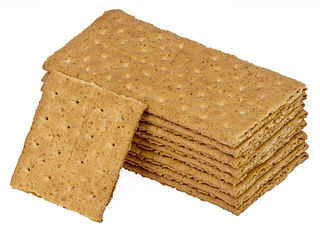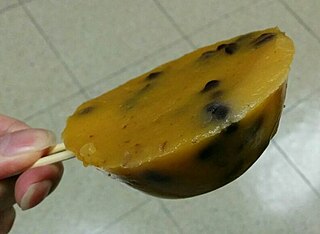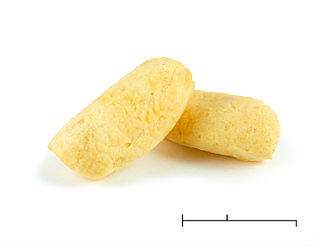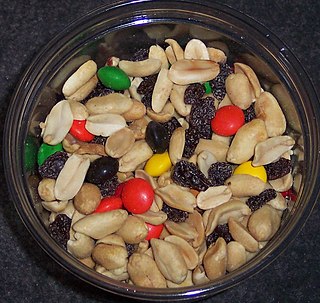
A graham cracker is a sweet flavored cracker made with graham flour that originated in the United States in the mid-19th century, with commercial development from about 1880. It is eaten as a snack food, usually honey- or cinnamon-flavored, and is used as an ingredient in some foods, e.g., in the graham cracker crust for cheesecakes and pies.

Hardtack is a type of dense biscuit or cracker made from flour, water, and sometimes salt. Hardtack is inexpensive and long-lasting. It is used for sustenance in the absence of perishable foods, commonly during long sea voyages, land migrations, and military campaigns. Along with salt pork and corned beef, hardtack was a standard ration for many militaries and navies from the 17th to the early 20th centuries.

Hong Kong cuisine is mainly influenced by Cantonese cuisine, European cuisines and non-Cantonese Chinese cuisines, as well as Japanese, Korean and Southeast Asian cuisines, due to Hong Kong's past as a British colony and a long history of being an international port of commerce. Complex combinations and international gourmet expertise have given Hong Kong the labels of "Gourmet Paradise" and "World's Fair of Food".

Senbei are a type of Japanese rice cracker. They come in various shapes, sizes, and flavors, usually savory but sometimes sweet. Senbei are often eaten with green tea as a casual snack and offered to visiting house guests as a courtesy refreshment.

A rice cracker is an East Asian cracker made from rice flour. They are fried or baked and often puffed and/or brushed with soy sauce or vinegar to create a smooth texture.

Put chai ko is a popular snack in Hong Kong. The pudding cake is palm size and is sweet in taste. It is soft, but can hold its molded shape outside a bowl. The cake is made from white or brown sugar, long-grain rice flour with a little wheat starch or cornstarch. Sometimes red beans are also added. The batter is poured into porcelain bowls and steamed until cooked through. Then it is allowed to cool and served at room temperature. Traditionally, the hawker inserts two bamboo skewers into the cake to turn it out and the eater holds the skewers to consume. At present, most Put Chai Ko are sold in plastic bags.

Want Want Holdings Limited is a food manufacturer from Taiwan. It is one of the largest rice cake and flavored drink manufacturers in Taiwan. It engages in the manufacturing and trading of snack foods and beverages, divided into four businesses: rice crackers, dairy products, beverages, snack foods, and other products. It operates over 100 manufacturing plants in mainland China and 2 in Taiwan, and employs over 60,000 people.

An egg waffle is a spherical egg-based waffle popular in Hong Kong and Macau, consisting of an eggy leavened batter cooked between two plates of semi-spherical cells. They are usually served hot, and often eaten plain, although they may be served with fruit and flavors such as strawberry, coconut or chocolate. It is referred to by its original Cantonese name, gai daan jai (雞蛋仔), and in English, an egg puff, bubble waffle, eggette, pancake balls, pancake waffle, egglet, and puffle. They are sometimes referred to as Hong Kong cakes in Chinatowns across America, especially in New York. One piece of egg waffle can have around 20 to 35 small round 'balls'.
Nantong Xiting Cracker, also possibly known as sesame seed cake, is one of the specialties of Nantong. It is known for the quality of its ingredients and the meticulous preparation involved in its production.

Amplang, also known as kerupuk kuku macan, is an Indonesian traditional savoury fish cracker snack commonly found in Indonesia and Malaysia. Amplang crackers are commonly made of ikan tenggiri (wahoo) or any type of Spanish mackerel, mixed with starch and other materials, and then fried.

Bing sutt is a type of traditional cold drinking house started in Guangzhou (Canton) that spread to Hong Kong. These bing sutts arose in the 1950s and 1960s. They are characterized by old furniture and settings such as the small tiled floors, hanging fans, folding chairs and so on. A bing sutt provides light meals and drinks and is neighbourhood-oriented. It is believed to be the predecessor of the cha chaan teng.

Hong Kong street food is characterised as the ready-to-eat snacks and drinks sold by hawkers or vendors at food stalls, including egg tarts, fish balls, egg waffles and stinky tofu, according to the definition provided by the Food and Agriculture Organization. They can be found throughout the city, especially in the areas of Mong Kok, Causeway Bay, Yuen Long, Tsuen Wan, and Kwun Tong.

Putting traditional candies into a Chinese candy box is a custom of Hong Kong people at Chinese New Year. In fact, there is a hidden meaning in this practice. It is said that people believe sweet candies symbolize an appealing and delightful start to the new year.

Krupuk (Javanese) is a cracker made from starch or animal skin and other ingredients that serve as flavouring. Most krupuk are deep fried, while some others are grilled or hot sand fried. They are a popular snack in maritime Southeast Asia, and are most closely associated with the culinary traditions of Indonesia, in particular Javanese cuisine. It is an ubiquitous staple in its country of origin, and has spread to other countries either via the migration of diaspora populations or exports.

Prawn crackers are a deep-fried snack made from starch and prawn. They are a common snack food in Southeast Asian cuisine, but they are most closely associated with Indonesia. They have also been adapted into East Asian cuisines, where the similar Japanese kappa ebisen (かっぱえびせん) and Korean saeukkang are popular snacks.
Traditional candy and coconut wrap is a traditional Cantonese snack. It is usually found on the street, where hawkers keep the wraps in a transparent metal box to sell. It is a wrap with hard sugar inside white wafer slice. It was especially famous in Hong Kong during the 1940s and 50s. The most popular fillings included shredded coconut, maltose and sesame.

A snack is a small portion of food generally eaten between meals. Snacks come in a variety of forms including packaged snack foods and other processed foods, as well as items made from fresh ingredients at home.
















